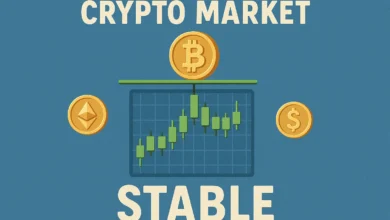Crypto Market Cap Soars to New All Time High

The global cryptocurrency landscape is electrified: the crypto market cap has just broken through to a new all-time high, asserting renewed confidence and momentum across digital assets. This milestone marks more than a price spike — it signals a deeper shift in investor sentiment, institutional adoption, and the maturation of the crypto ecosystem. For those watching, this surge is proof that crypto is no longer a fringe experiment but a major contender in global finance.
In this article, we delve into what lies behind this explosive growth, which assets are driving the rally, how different sectors (Bitcoin, altcoins, stablecoins) are reacting, and what potential risks lie ahead. We’ll also explore the broader implications for investors, regulators, and the future of digital finance. Through detailed analysis under clear headings, you’ll gain a full understanding of the forces at play behind the crypto market cap hits new all-time high headline.
The Landmark Surge: How High Did It Go
When we say the crypto market cap hits new all-time high, what do we mean exactly? The total market capitalization of all cryptocurrencies — the sum of (price × circulating supply) for each token — recently crested a record level. According to some data sources, that new peak reached about $4.13 trillion, surpassing prior highs. Other reports note a figure near $4.14 trillion, signaling a 22 % rise year-to-date with over $750 billion in fresh capital inflows. Meanwhile, CoinCodex records place the all-time high at $4.20 trillion as of August 2025.
Records were more modest: the market had earlier broken $3.8 trillion territory, a feat that made waves in its own right. In those prior highs, Bitcoin was already climbing toward new peaks of its own, often in lockstep with the total market. These historical reference points highlight just how dramatic the current rally is.
It’s worth noting that while the total crypto market cap is surging, performance and contribution are uneven — some assets are doing the heavy lifting, others are riding the wave, and some lag behind. The breakdown is critical for understanding risk and opportunity.
What’s Fueling the Rally Behind the New High
Institutional Inflows and Corporate Adoption
One of the strongest drivers in this latest run is the entrance and deepening commitment of institutional capital. Large asset managers, hedge funds, pension funds, and private corporations are increasingly allocating to crypto — particularly Bitcoin and Ethereum — for diversification, inflation hedging, and return potential. This trend lends credibility and stability to the market, smoothing bouts of volatility that plagued earlier cycles.
Regulatory Clarity and Favorable Policy Moves
Even as regulators around the world wrestle with how to oversee digital assets, recent developments are tilting toward clarity rather than crackdown. In some jurisdictions, new frameworks are emerging for crypto exchanges, stablecoins, and token listings, which reduce risk and uncertainty for big money participants.
For example, stablecoins have recently drawn attention from lawmakers, with regulatory bills being considered that would require more transparency and backing. Such steps can reassure investors that the industry is not a “Wild West” devoid of oversight but a nascent financial frontier getting structure.
DeFi, Layer-1 Ecosystems & Smart Contract Growth
Beyond Bitcoin, growth in decentralized finance (DeFi) protocols, layer-1 blockchain ecosystems, and smart contract applications is adding real utility to the crypto narrative. As these infrastructures mature, capital flows into projects that solve real problems: yield farming, lending platforms, decentralized exchanges, and NFTs. The success of these use cases encourages additional capital into the broader market — creating a virtuous cycle.
Market Sentiment, Momentum, and FOMO
Momentums tend to feed themselves, particularly in volatile asset classes. As the crypto market cap pushes records, more traders and retail investors fear missing out (FOMO). This psychological driver magnifies trends once a clear breakout occurs. Technical signals such as resistance breaks, upward trendlines, and moving-average crossovers amplify the effect.
Macro Tailwinds: Inflation, Monetary Policy & Risk Appetite
Global macro conditions also play a key role. High inflation, currency devaluation, negative real interest rates, and accommodative (or uncertain) central bank policies make alternative stores of value more appealing. Cryptocurrencies, especially Bitcoin, are increasingly viewed as a hedge against macro risk — a digital “alternate asset class.” In times of quantitative easing or dollar weakness, crypto can benefit from liquidity chasing yield.
Who’s Leading the Charge? Breaking It Down by Sector

Bitcoin: Still Reigning King
Bitcoin remains the dominant driver in the crypto market cap hits new all-time high story. As the original and most mature crypto, BTC often leads the pack when markets surge. Recent data shows Bitcoin repeatedly hitting new price highs — for example, surpassing $109,500 on May 21, 2025, overtaking market caps of giants like Amazon and Google in pure valuation terms. Later in 2025, BTC pushed into the $117,000 range in another milestone run.
Beyond price, Bitcoin’s market dominance (its proportion of total crypto capitalization) often increases during broad rallies, acting as an anchor for confidence.
Ethereum & Smart-Contract Tokens
Ethereum and smart contract tokens are critical in supporting the narrative that crypto is more than digital gold. Recently, Ethereum smashed its own all-time high, nearing $4,945, putting its market cap close to $600 billion. In this rally, ETH and associated token ecosystems are gaining renewed attention as institutional capital flows into programmable blockchains.
Other layer-1 tokens — Solana, Avalanche, Cosmos, etc. — are benefiting from spillover as users and capital seek high-throughput and lower-fee alternatives. Their growth adds breadth to the rally beyond just Bitcoin and Ethereum.
Altcoins, DeFi & Emerging Projects
While many altcoins lag behind the giants in stability, some explosive gainers are contributing to the broader market cap. Projects in DeFi, infrastructure, NFT platforms, and novel tokenomics are capturing investor imagination. However, their performance is often more volatile, and some are speculative bets riding the bullish tide.
Stablecoins: The Anchor of Liquidity
Though stablecoins don’t surge in price (by design), their market cap and usage are essential to market health. Recently, stablecoins’ total market cap soared to over $300 billion, reflecting their role as liquidity reservoirs in crypto trades. As traders move in and out of volatile positions, stablecoins act as the parking lot for capital, reinforcing market stability and facilitating flows. Their expansion is partly a byproduct of the broader rally.
Market Dynamics, Risks & Technical Considerations
Overheating & Correction Risk
Whenever any asset hits a fresh peak, the risk of overheating becomes real. Rapid inflows, speculative frenzy, and overly aggressive leverage can lead to sharp reversals. Pullbacks are part of healthy markets, and volatility will likely intensify as participants take profits or rebase positions.
Liquidity Constraints & Slippage
Even though the crypto market is bigger than ever, large institutional orders can incur slippage, especially in less liquid tokens. Depth on top-tier pairs is better, but for smaller altcoins, executing big trades can push prices against the buyer, eating into returns.
Regulatory Reversals & Policy Shocks
Regulatory risk remains a wildcard. Governments could impose tighter controls, taxation, bans, or restrictions on crypto activity. Politically motivated shifts — or surprise rulings — may derail momentum quickly. For now, many recent moves favor regulation rather than prohibition, but risks persist.
Technical Resistance Zones
From a charting perspective, breakouts beyond prior peaks often prompt retests: fast climbs may meet resistance levels that cap gains temporarily. In addition, overbought technical indicators (RSI, MACD) can warn of impending retracements. Buyers should watch for volume confirmation and consolidation zones.
Concentration Risk & Whale Dominance
Because a large share of crypto wealth is held by so-called “whales” (very large holders), price dynamics can be manipulated or distorted by major trades. Sudden shifts in whale behavior can produce outsized volatility. Moreover, high capitals flowing into a few assets may reduce breadth in the rally.
Implications for Investors, Institutions & Market Structure
Entry Strategies & Timing
For investors, the window to enter during a breakout is narrow. Some will adopt dollar-cost averaging (DCA) — slowly accumulating over time — to mitigate timing risk. Others may prefer to trail the trend, entering after confirmation. Caution is wise in chasing fast-moving breakout runs.
Portfolio Diversification & Risk Management
Given the uneven contributions of different sectors (Bitcoin, altcoins, DeFi), balancing exposure is key. A core in BTC and ETH provides stability, while selective altcoin positions offer speculative upside. Risk management — including position sizing and stop-loss tactics — becomes essential in a high-vol environment.
Institutional Infrastructure & Custody
The surge in market capitalization demands robust infrastructure. Custodial services, secure storage, regulatory compliance, insurance, and institutional-grade tools are required to onboard more institutional capital. This growth pressure fosters the building of better exchanges, compliance platforms, and DeFi bridges.
Evolving Market Maturity
A record-breaking crypto market cap is a signal of maturation. As the market scales, it becomes harder to swing with small events — meaning fundamentals, macro variables, and regulatory clarity will play bigger roles. Moreover, comparisons between crypto and traditional asset classes (stocks, gold, real estate) become more relevant to institutional allocators.
Competitive Landscape with Traditional Assets
With crypto capitalization now rivaling or exceeding large national GDPs (e.g. near UK-level) and overcoming prior mental barriers, its role in global finance is harder to dismiss. Assets like equities, bonds, real estate, and commodities are now more likely to be compared or correlated with crypto in institutional allocation models.
What’s Next: Scenarios & Projections
Bull Continuation: Expansion to $5T+
If momentum holds and regulatory tailwinds persist, many analysts see targets of $4.5T to $5T+ for total crypto capitalization. Some chart patterns (inverse head-and-shoulders) suggest a potential run in that direction. Institutional pipelines, improved DeFi performance, and broader adoption could fuel that upward ride.
Sideways Consolidation & Retest
Markets often “take a breath” after sharp moves. We may see the crypto market cap hit a resistance zone and then consolidate sideways, testing support levels before making further decisions. Such periods are healthy for digestion and accumulation.
Correction or Pullback Phase
It’s also possible that the rally faces a correction of 10–25 % or more, especially if sentiment becomes overstretched or a negative regulatory surprise hits. That does not necessarily invalidate the trend; corrections are part of healthy bull cycles.
Divergence & Sector Rotation
Even under a bullish regime, rotation between sectors is likely. Capital may move away from overextended altcoins toward more stable blue-chips (Bitcoin, Ethereum) or even into new themes like crypto AI (which has hit a $32 billion valuation recently) or Layer-2 scaling plays.
Regulatory Convergence & Institutional Benchmarking
In the longer term, regulatory certainty and institutional product creation (e.g. ETFs, tokenized securities, compliant DeFi platforms) may lock in gains and reduce volatility. A more mature regulatory regime would allow traditional investors to feel safer in crypto exposure.
Price Highlights & Notable Coin Moves

While the headline of crypto market cap hits new all-time high grabs attention, several coins deserve mention in this rally:
-
Bitcoin (BTC): Climbing past $109,500 and later $117,000 levels.
-
Ethereum (ETH): Touched new record highs over $4,945, pushing its market cap close to $600 billion.
-
BNB: Recently set a fresh ATH, crossing $1,000 in notable upside momentum.
-
Stablecoins: Tether, USDC, and others now exceed $300 billion total market cap, strengthening their role as liquidity anchors.
These movements, especially at the top tiers, are disproportionately affecting the total market cap surge. Tracking dominance ratios (e.g. BTC dominance) is also helpful to interpret whether breadth is also improving or if the rally is narrow.
Key Takeaways & Strategic Guidance
-
The fact that crypto market cap hits new all-time high means that investor confidence, capital flows, and infrastructure are aligning around crypto’s maturation.
-
Bitcoin remains central to rally strength, but Ethereum and other smart contract ecosystems are performing strongly too.
-
Risks such as regulatory shifts, technical reversals, and overextension should not be ignored — disciplined risk management is essential.
-
For investors, gradual exposure (e.g. dollar-cost averaging), balanced allocations, and staying alert to macro and policy developments are prudent approaches.
-
The long road ahead may include sideways phases, deeper adoption, and structural evolution that strengthens crypto’s position in global finance.
Also Read: Best Crypto Marketing Consultant for NFTs Expert Strategies & Results
Conclusion
The moment when the crypto market cap hits a new all-time high is a defining milestone in the evolution of digital assets. It signals that crypto is not merely a speculative corner of finance but a growing force in global capital markets. Behind the headlines lie deep shifts — institutional influx, regulatory progress, technological maturation, and macro tailwinds all converging to power this rally.
While opportunities abound, the environment remains volatile and uncertain. Success in this phase will favor participants who combine conviction with discipline, who understand both fundamentals and risk. Whether the market continues climbing or phases into consolidation, the fact remains: we are witnessing the next chapter in crypto’s story. This peak may only be the beginning.
FAQs
Q: What exactly counts toward the “crypto market cap”?
The crypto market cap is the sum of the market capitalization of every cryptocurrency: for each coin or token, it is (price per coin × circulating supply). These are aggregated across all tradable tokens. The result is the total value investors assign to the digital asset universe at a point in time.
Q: Why does Bitcoin often lead the rally in total market cap?
Bitcoin often leads because it is the oldest, most liquid, best known, and most institutionally accepted cryptocurrency. It tends to attract large inflows first. Also, many investors view BTC as digital gold or a reserve asset within crypto, giving it a structural priority in capital allocation during rallies.
Q: How should ordinary investors approach a rally like this?
Retail participants should consider strategies like dollar-cost averaging (gradual accumulation) and avoid betting too heavily on ultra-speculative assets. Diversification across blue-chip cryptos and smaller positions in higher-risk bets can balance upside and downside. Importantly, managing drawdowns and using appropriate position sizing is key.
Q: What are the biggest risks that could derail the rally?
Key risks include: (a) sudden regulatory changes or bans; (b) large-scale liquidations or whale moves; (c) macro shocks (interest rate hikes, inflation surprises); (d) technical exhaustion or overbought conditions. Any one of these can trigger sharp pullbacks.
Q: Does hitting a new all-time high guarantee further gains?
No, it doesn’t guarantee continued gains. Breakouts can lead to further expansion, or they can fail and result in retracements. Historical precedents show that markets sometimes test the breakout level, consolidate, or even reverse. Confirmation via volume, momentum, and macro alignment is often needed to sustain upward trends.




